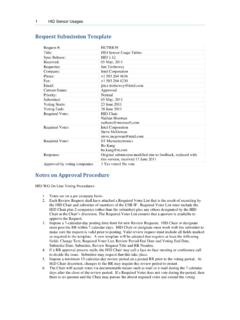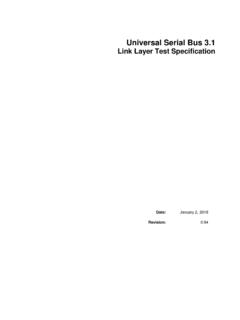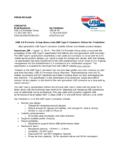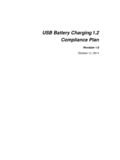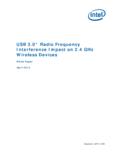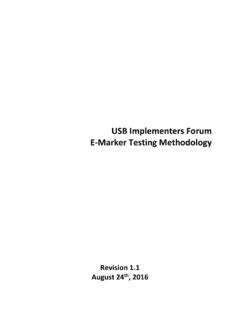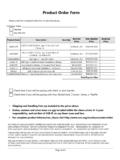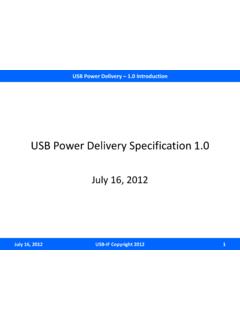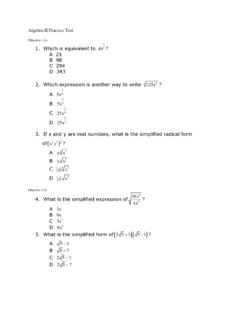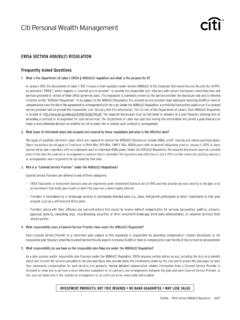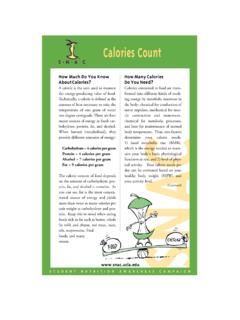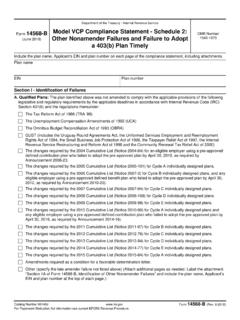Transcription of USB 2.0 Specification Engineering Change Notice …
1 USB Specification Engineering Change Notice (ECN) #1: Mini-B connectorDate: 10/20/2000 Reason for ECN:The USB specified device-side connector the B connector is too large for use witha new generation of handheld and mobile devices, , cell phones which would benefitfrom connectivity to the PC. This ECN incorporates a Specification of a device-side miniconnector (hereafter referred to as a mini-B connector). The new connector only appliesto upstream facing ports, , connectors on of ECN:The bulk of the ECN specifies the mechanical requirements for the mini-B plug,receptacle and cable assembly.
2 It also identifies the usage scope of this connector. Thelast part of the ECN describes the minimum test criteria and performance requirementsfor the new of ECN:The ECN enables standardization of miniature device-side USB connectors andconsequent economies of scales and lower cost for a new and growing class of deviceswhich will benefit from connectivity to the PC. The standardization also allowsleveraging of the compliance test and certification model which is already in place forUSB of Impact on Current Specification and Current USB Products:The connector specified in the ECN will not have any impact on hardware or software ofexisting USB products.
3 The current USB spec already allows for vendor-specific deviceside connectors such cable assemblies are called captive assemblies. All that the ECNdoes is to identify one such connector for use in devices which need the smaller size ofconnector. There is a potential for some end-user confusion because of two standardcable options; but this can be mitigated by appropriate end-user of ECN:The ECN is in the form of a new Chapter 6 with the mini-B connector requirementsinserted into the appropriate locations. This format enables Specification of the newconnector in Serial Bus Specification Revision 6 MechanicalThis chapter provides the mechanical and electrical specifications for the cables, connectors, and cableassemblies used to interconnect USB devices.
4 The Specification includes the dimensions, materials,electrical, and reliability requirements. This chapter documents minimum requirements for the externalUSB interconnect. Substitute material may be used as long as it meets these Architectural OverviewThe USB physical topology consists of connecting the downstream hub port to the upstream port of anotherhub or to a device. The USB can operate at three speeds. High-speed (480 Mb/s) and full-speed (12 Mb/s)require the use of a shielded cable with two power conductors and twisted pair signal conductors. Low-speed ( Mb/s) recommends, but does not require the use of a cable with twisted pair signal connectors are designed to be hot plugged.
5 The USB Icon on the plugs provides tactile feedbackmaking it easy to obtain proper Keyed Connector ProtocolTo minimize end user termination problems, USB uses a keyed connector protocol. The physicaldifference in the Series A and B (or mini-B ) connectors insures proper end user connectivity. The A connector is the principle means of connecting USB devices directly to a host or to the downstreamport of a hub. All USB devices must have the standard Series A connector specified in this chapter. The B (or mini-B ) B connector allows device vendors to provide a standard detachable cable.
6 Thisfacilitates end user cable replacement. Figure 6-1 Figure 6-1 illustrates the keyed connector Serial Bus Specification Revision "A" ConnectorsSeries "B" Connectors Series "A" plugs arealways oriented upstreamtowards the Host System Series "B" plugs arealways orienteddownstream towards theUSB Device"A" Plugs(From theUSB Device)"B" Plugs(From theHost System)"B" Receptacles(Upstream Input to theUSB Device or Hub)"A" Receptacles(Downstream Outputfrom the USB Host orHub) Series "mini-B" Connectors Series "mini-B" plugs are always oriented downstream towards the USB Device "mini-B" Plugs (From the Host System) "mini-B" Receptacles (Upstream Input to the USB Device or Hub) Figure 6-1.
7 Keyed Connector ProtocolUniversal Serial Bus Specification Revision following list explains how the plugs and receptacles can be mated: Series A receptacle mates with a Series A plug. Electrically, Series A receptacles function asoutputs from host systems and/or hubs. Series A plug mates with a Series A receptacle. The Series A plug always is oriented towardsthe host system. Series B receptacle mates with a Series B plug (male). Electrically, Series B receptaclesfunction as inputs to hubs or devices. Series B plug mates with a Series B receptacle.
8 The Series B plug is always oriented towardsthe USB hub or device. Series mini-B receptacle mates with a Series mini-B plug (male). Electrically, Series mini-B receptacles function as inputs to hubs or devices. Series mini-B plug mates with a Series mini-B receptacle. The Series mini-B plug is alwaysoriented towards the USB hub or CableUSB cable consists of four conductors, two power conductors, and two signal cable consists of a signaling twisted pair, VBUS, GND, and an overall shield. High-/full-speed cable must be marked to indicate suitability for USB usage (see Section ).
9 High-/full-speedcable may be used with either low-speed, full-speed, or high-speed devices. When high-/full-speed cable isused with low-speed devices, the cable must meet all low-speed recommends, but does not require the use of a cable with twisted signaling Cable AssemblyThis Specification describes three USB cable assemblies: standard detachable cable, high-/full-speedcaptive cable, and low-speed captive standard detachable cable is a high-/full-speed cable that is terminated on one end with a Series A plugand terminated on the opposite end with a series B (or mini-B ) B plug.
10 A high-/full-speed captivecable is terminated on one end with a Series A plug and has a vendor-specific connect means (hardwiredor custom detachable) on the opposite end for the high-/full-speed peripheral. The low-speed captive cableis terminated on one end with a Series A plug and has a vendor-specific connect means (hardwired orcustom detachable) on the opposite end for the low-speed peripheral. Any other cable assemblies color used for the cable assembly is vendor specific; recommended colors are white, grey, or Standard Detachable Cable AssembliesHigh-speed and full-speed devices can utilize the B (or mini-B ) B connector.

